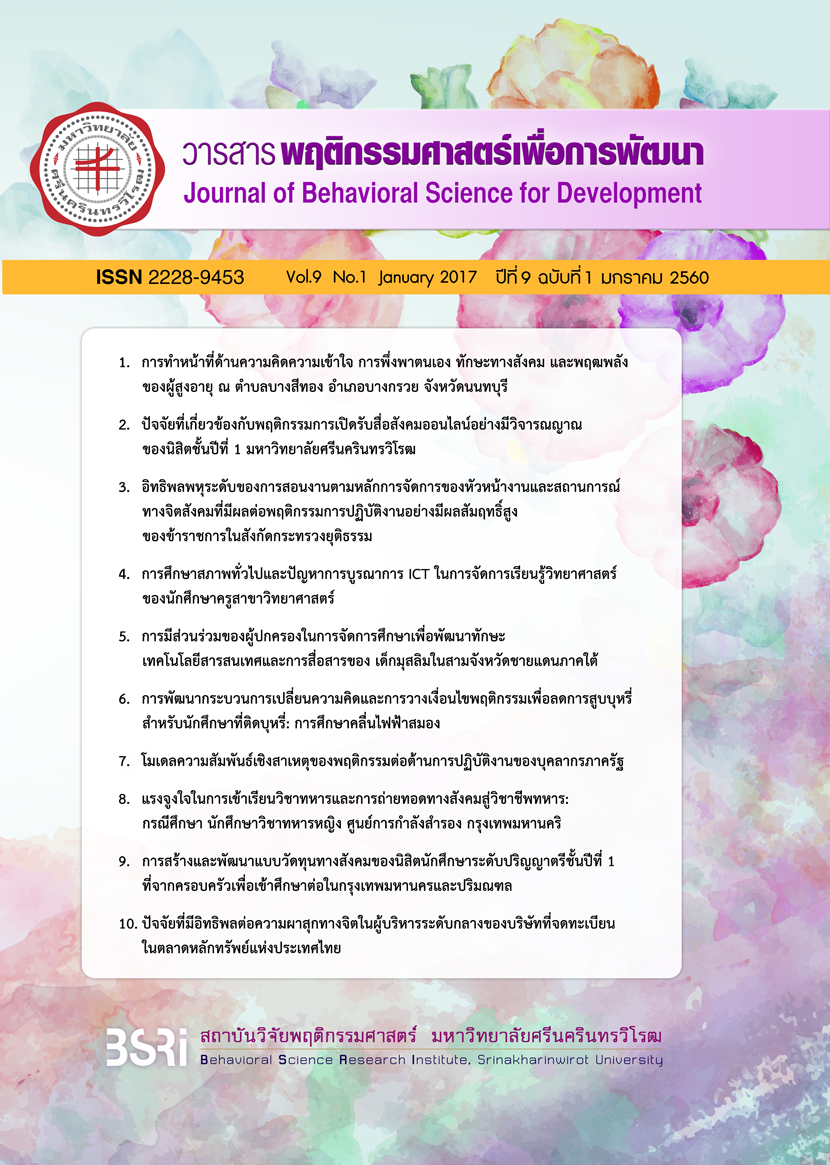โมเดลความสัมพันธ์เชิงสาเหตุของ พฤติกรรมต่อต้านการปฏิบัติงานของบุคลากรภาครัฐ A Causal Relationship Model of Government Personnel’s Counterproductive Work Behavior (โมเดลความสัมพันธ์เชิงสาเหตุของพฤติกรรมต่อต้านการปฏิบัติงานของบุคลากรภาครัฐ)
Keywords:
work locus of control, adversity quotient, trust, job stress, counterproductive work behavior ความเชื่ออำนาจการควบคุมในงาน ความสามารถในการเผชิญและฟันฝ่าอุปสรรค ความไว้วางใจ ความเครียดในงาน พฤติกรรมต่อต้านการปฏิบัติงานAbstract
The study’s purpose was to develop and investigate the validity of causal relationship model of personnel’s counterproductive work behavior with empirical study. The samples of this study were 558 government officials and employees in 16 government offices from economic ministries. In this study, questionnaires were used to collect data about five variables as follows: work locus of control, adversity quotient, trust, job stress, and counterproductive work behavior. Structural equation modeling (SEM) was used to analyze data. Results indicated that the structural model was consistent with empirical data as demonstrated by the following indices: chi-square (2) = 43.879, degrees of freedom (df) = 40, p-value = 0.311, root mean square error of approximation (RMSEA) = 0.013, comparative fit index (CFI) = 0.999, relative fit index (RFI) = 0.985, and standardized RMR = 0.025. 28.2% of the variance in associated with counterproductive work behavior was explained by four predictors. Specifically, job stress had the strongest direct effect on counterproductive work behavior. This finding added to the debate regarding job stress as a mediator between adversity quotient and counterproductive work behavior.
Keywords: work locus of control, adversity quotient, trust, job stress, counterproductive work behavior
บทคัดย่อ
การศึกษานี้มีวัตถุประสงค์เพื่อพัฒนาและตรวจสอบความตรงของโมเดลความสัมพันธ์เชิงสาเหตุของพฤติกรรมต่อต้านการปฏิบัติงานของบุคลากรภาครัฐกับข้อมูลเชิงประจักษ์ ตัวอย่างคือข้าราชการและพนักงานราชการที่ปฏิบัติงานในสังกัดราชการบริหารส่วนกลาง 16 ส่วนราชการจากกลุ่มกระทรวงด้านเศรษฐกิจ จำนวน 558 คน เครื่องมือคือแบบสอบถาม ใช้ในการเก็บรวบรวมข้อมูล 5 ตัวแปร ได้แก่ ความเชื่ออำนาจการควบคุมในงาน ความสามารถในการเผชิญและฟันฝ่าอุปสรรค ความไว้วางใจ ความเครียดในงาน และพฤติกรรมต่อต้านการปฏิบัติงาน โดยใช้การวิเคราะห์โมเดลสมการโครงสร้าง ผลการศึกษาพบว่า โมเดลความสัมพันธ์เชิงสาเหตุของพฤติกรรมต่อต้านการปฏิบัติงานของบุคลากรมีความสอดคล้องกลมกลืนกับข้อมูลเชิงประจักษ์ พิจารณาจากไค-สแควร์ (2) มีค่าเท่ากับ 43.879 ที่องศาอิสระ 40 ระดับนัยสำคัญ .311 ค่ารากกำลังสองเฉลี่ยของค่าความแตกต่างโดยประมาณ (RMSEA) เท่ากับ 0.013 ค่าดัชนีวัดระดับความสอดคล้องเปรียบเทียบ (CFI) เท่ากับ 0.999 ค่า Relative Fit Index (RFI) เท่ากับ 0.985 และค่าดัชนีรากของค่าเฉลี่ยกำลังสองของส่วนที่เหลือมาตรฐาน (SRMR) เท่ากับ 0.025 ทั้งนี้ตัวแปรในโมเดลทั้ง 4 ตัว อธิบายความแปรปรวนในตัวแปรพฤติกรรมต่อต้านการปฏิบัติงานได้ร้อยละ 28.2 โดยความเครียดงานมีอิทธิพลทางตรงต่อพฤติกรรมต่อต้านการปฏิบัติงานมากที่สุด นอกจากนี้ความเครียดในงานยังมีบทบาทเป็นตัวแปรส่งผ่านระหว่างอิทธิพลของความสามารถในการเผชิญและฟันฝ่าอุปสรรคกับพฤติกรรมต่อต้านการปฏิบัติงาน
คำสำคัญ: ความเชื่ออำนาจการควบคุมในงาน ความสามารถในการเผชิญและฟันฝ่าอุปสรรค
ความไว้วางใจ ความเครียดในงาน พฤติกรรมต่อต้านการปฏิบัติงาน


